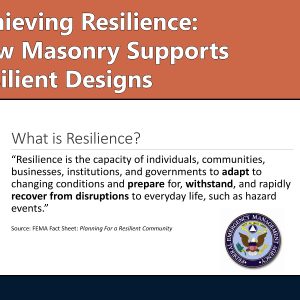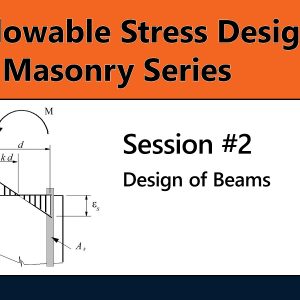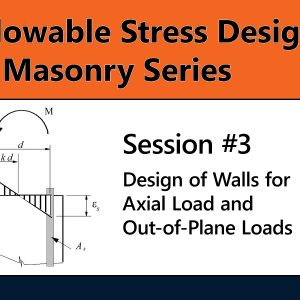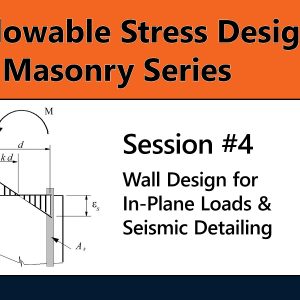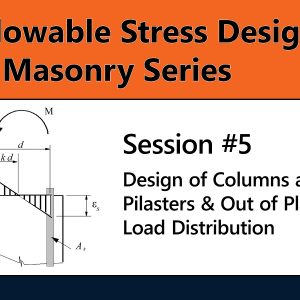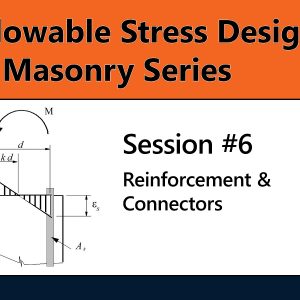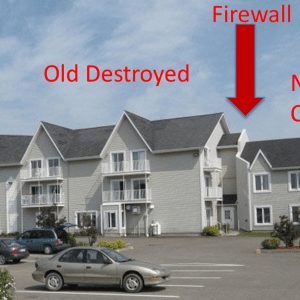Design
Showing 1–12 of 26 results
-
Achieving Resilience: How Masonry Supports Resilient Designs
This course provides an overview of resilient design and discusses how resilient design is and is not covered by building codes and standards. The role of masonry construction in meeting resilient design goals is explained, and the inherent properties of masonry that make it resilient are described. Examples of resilient design strategies are provided.
Learning Objectives:
- Define resilience.
- Explain how resilient designs go beyond the minimum building code requirements.
- List at least three above-code standards that can be used with resilient designs.
- Describe inherent properties of masonry that provide resilience.
$75.00 -
Allowable Stress Design
Allowable Stress Design of Masonry #1: Introduction to Allowable Stress Design
$75.00 Add to cartAllowable Stress Design of Masonry #1: Introduction to Allowable Stress Design
This introductory course reviews basic allowable stress design concepts. Dr. McGinley presents key differences between allowable stress design and strength design procedures. This session also reviews masonry assemblies and systems, noting their purposes and resistance to primary loads. Attendees will learn about typical masonry building elements and their roles in the overall structural system including walls, beams, columns, and pilasters. Future sessions of the series discuss the design of these elements. Finally, this session reviews loads and load combinations from ASCE-7 & and the IBC.
Allowable Stress Design of Masonry introduces Allowable Stress Design (ASD) of Masonry, review code requirements, and examine designs of common masonry elements including, beams, walls, columns, and pilasters. The series discusses design methodology as well as design for flexure, axial loads, and in-plane loads. It concludes with a review of requirements for reinforcement and connectors and detailing masonry effectively. It is recommended that you have a basic familiarity with masonry (consistent with content presented in the Masonry 101 Series).
View other courses in this series or purchase the Allowable Stress Design Bundle to access all 6 and save $30 compared to buying them separately.
$75.00 -
Allowable Stress Design of Masonry #2: Design of Beams
This course reviews allowable stress design of masonry beams and lintels and provides an examination of whether arching action can be used to reduce the loads on these elements. Deflection calculations are reviewed, along with code compliance requirements relating to reinforcement and grouting. This session also covers partial depth beams, deep beams, shear reinforcement, long-span beam criteria, torsion, and other requirements.
Allowable Stress Design of Masonry introduces Allowable Stress Design (ASD) of Masonry, review code requirements, and examine designs of common masonry elements including, beams, walls, columns, and pilasters. The series discusses design methodology as well as design for flexure, axial loads, and in-plane loads. It concludes with a review of requirements for reinforcement and connectors and detailing masonry effectively. It is recommended that you have a basic familiarity with masonry (consistent with content presented in the Masonry 101 Series).
View other courses in this series or purchase the Allowable Stress Design Bundle to access all 6 and save $30 compared to buying them separately.
$75.00 -
Allowable Stress Design
Allowable Stress Design of Masonry #3: Design of Walls for Axial Load and Out-of-Plane Loads
$75.00 Add to cartAllowable Stress Design of Masonry #3: Design of Walls for Axial Load and Out-of-Plane Loads
During this session, allowable stress design of masonry walls loaded with out-of-plane loads and axial loads will be reviewed. Differences in the Allowable Stress design provisions and strength design procedures will be briefly discussed, especially the secondary bending moments.
Allowable Stress Design of Masonry introduces Allowable Stress Design (ASD) of Masonry, review code requirements, and examine designs of common masonry elements including, beams, walls, columns, and pilasters. The series discusses design methodology as well as design for flexure, axial loads, and in-plane loads. It concludes with a review of requirements for reinforcement and connectors and detailing masonry effectively. It is recommended that you have a basic familiarity with masonry (consistent with content presented in the Masonry 101 Series).
View other courses in this series or purchase the Allowable Stress Design Bundle to access all 6 and save $30 compared to buying them separately.
$75.00 -
Allowable Stress Design
Allowable Stress Design of Masonry #4: Wall Design for In-Plane Loads & Seismic Detailing
$75.00 Add to cartAllowable Stress Design of Masonry #4: Wall Design for In-Plane Loads & Seismic Detailing
Shear walls are critical building elements to resist in-plane loads and are, for masonry, the wind and seismic-force-resisting system. This session reviews Allowable Stress Design of shear walls along with both seismic detailing requirements and minimum/maximum detailing requirements for such walls. Design for in-plane shear, including shear friction, and in-plane flexure is explored and examples provided. The effect of openings are also be examined.
Allowable Stress Design of Masonry introduces Allowable Stress Design (ASD) of Masonry, review code requirements, and examine designs of common masonry elements including, beams, walls, columns, and pilasters. The series discusses design methodology as well as design for flexure, axial loads, and in-plane loads. It concludes with a review of requirements for reinforcement and connectors and detailing masonry effectively. It is recommended that you have a basic familiarity with masonry (consistent with content presented in the Masonry 101 Series).
View other courses in this series or purchase the Allowable Stress Design Bundle to access all 6 and save $30 compared to buying them separately.
$75.00 -
Allowable Stress Design
Allowable Stress Design of Masonry #5: Design of Columns and Pilasters & Out of Plane Load Distribution
$75.00 Add to cartAllowable Stress Design of Masonry #5: Design of Columns and Pilasters & Out of Plane Load Distribution
Shear walls are critical building elements to resist in-plane loads and are, for masonry, the wind and seismic-force-resisting system. This session reviews Allowable Stress Design of shear walls along with both seismic detailing requirements and minimum/maximum detailing requirements for such walls. Design for in-plane shear, including shear friction, and in-plane flexure is explored and examples provided. The effect of openings are also be examined.
Allowable Stress Design of Masonry introduces Allowable Stress Design (ASD) of Masonry, review code requirements, and examine designs of common masonry elements including, beams, walls, columns, and pilasters. The series discusses design methodology as well as design for flexure, axial loads, and in-plane loads. It concludes with a review of requirements for reinforcement and connectors and detailing masonry effectively. It is recommended that you have a basic familiarity with masonry (consistent with content presented in the Masonry 101 Series).
View other courses in this series or purchase the Allowable Stress Design Bundle to access all 6 and save $30 compared to buying them separately.
$75.00 -
Allowable Stress Design
Allowable Stress Design of Masonry #6: Reinforcement & Connectors
$75.00 Add to cartAllowable Stress Design of Masonry #6: Reinforcement & Connectors
Reinforcement and connectors are essential to ensure a proper load path in masonry buildings. This session reviews basic detailing requirements for reinforcement and connectors and specific requirements for their design when using allowable stress procedures for masonry. Lap length requirements for reinforcement, use of hooks and confinement bars, and the design of anchor bolts are also be reviewed.
Allowable Stress Design of Masonry introduces Allowable Stress Design (ASD) of Masonry, review code requirements, and examine designs of common masonry elements including, beams, walls, columns, and pilasters. The series discusses design methodology as well as design for flexure, axial loads, and in-plane loads. It concludes with a review of requirements for reinforcement and connectors and detailing masonry effectively. It is recommended that you have a basic familiarity with masonry (consistent with content presented in the Masonry 101 Series).
View other courses in this series or purchase the Allowable Stress Design Bundle to access all 6 and save $30 compared to buying them separately.
$75.00 -
An Overview of the Role of Masonry in Sustainable Design and LEED v4
This lesson will address LEED v4 credit categories, with particular emphasis on the Materials and Resources credits, and identify how masonry products can contribute to sustainable design and LEED.
$75.00 -
Anchor Bolt Design
This lesson covers the basis for these changes two major changes to the anchor bolt design provisions in the 2016 edition of TMS 402. One change was to increase the calculated shear crushing strength by 67%. The other change was to go from a linear interaction equation for combined bending and shear to an elliptical interaction equation.
$75.00 -
Balanced Fire Safety Design and Resilient Masonry Fire Walls
This course reviews US fire statistics, the Balanced Fire Safety Design concept and the role that passive masonry firewalls play in it. Examples of how today’s building codes have eroded the Balanced Design Concept are shared to provide a better understanding of the crucial role fail-safe, passive masonry fire walls play in today’s fire safety designs. To gain insight into wall assembly and material performance the ASTM E-119 fire test method that is used to qualify and quantify fire walls is reviewed along with the ACI/TMS 216 code requirements for concrete and masonry wall assembly fire resistance ratings.
$75.00 -
Design and Detailing of Perforated Screen Walls
Architects are using brick in unique ways as a material of choice and have experimented with incorporating voids in the cladding. Brick screen walls have been used in residential applications for decades to screen undesirable elements such as trash and HVAC equipment. In fact, perforated walls were common in Persia dating back centuries. Now, architects are using screen walls for the entire façade of a structure. With this increased usage is an increased desire to have rules on how to design these elements. Brian E. Trimble, Director, Industry Development and Technical Services of the International Masonry Institute explores the various ways that perforations can be incorporated within a wall cladding. General rules of thumb will be shown on whether these walls can be used for certain projects. Some information on structural design will be provided, but that information is currently lacking due to lack of research. Examples of how perforated walls were designed on projects around the world will be showcased leading to ways to design these walls.
$75.00 -
Design of Masonry Shear Walls
The design of reinforced masonry shear walls using both the Allowable Stress Design method and the Strength Design method is covered in this lesson.
$75.00

